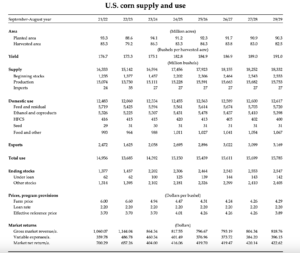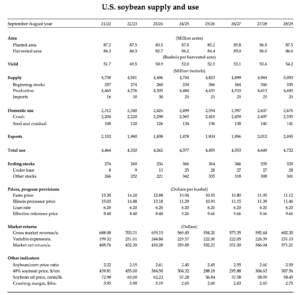Agriculture Secretary Brooke Rollins said on Tuesday that the Trump administration will announce a 'bridge payment' for farmers next week that is designed to provide short-term relief while longer trade…
FAPRI Baseline Update- Grain and Soybean Variables in Focus
The Food and Agricultural Policy Research Institute (FAPRI) at the University of Missouri released its latest baseline update for U.S. agricultural markets on Tuesday.
In part, the baseline update stated that, “Many of the factors that pushed prices of several agricultural commodities to record or near‐record levels in 2022 have reversed, or at least moderated, in 2023. World grain production is up this year, central banks have tightened monetary policy, and some input costs have receded.
With the important exception of cattle, prices for most U.S. farm products have declined in 2023. Crop prices could decline further in 2024 under a set of plausible assumptions.
More narrowly, the baseline pointed out that, “Farmers planted more corn this spring, so August estimates from USDA show a rebound in U.S. corn production in 2023. More production contributes to lower prices, as the marketing year average price falls from $6.60 per bushel in 2022/23 to $4.94 for the crop harvested this fall.

“The proportional decline in soybean prices is smaller, from $14.20 per bushel for the 2022/23 crop to $12.88 in 2023/24. USDA estimates that U.S. soybean production will decline slightly this year because of reduced acreage planted. South American production is projected to increase.”

The FAPRI update also noted that, “The war in Ukraine contributed to an upward spike in wheat prices in 2022. Wheat prices have fallen back given adequate global supplies, even though U.S. wheat yields are below the long‐term trend for the third straight year in 2023.”
Projected crop prices decline in 2023 and 2024 in @FAPRI_MU's update of the market outlook. https://t.co/b8cW66UMBM pic.twitter.com/VQ84l8EEC5
— Pat Westhoff (@WesthoffPat) September 5, 2023
In a closer look at input costs, Tuesday’s update stated that, “Prices for fertilizer increased dramatically in 2022 but have since declined. Estimated per‐acre variable costs for many crops decline in 2023, but the result is sensitive to when producers made input purchase decisions. Given projected prices for fertilizer and other inputs, costs for corn and other crops decline further in 2024 and 2025.”





